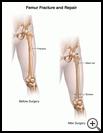
Thighbone (Femur) Fracture
________________________________________________________________________
KEY POINTS
- A thighbone fracture is a break or crack in the bone of your upper leg.
- Most thighbone fractures need to be repaired with surgery. Casts are rarely used for thighbone fractures in healthy adults. Your provider will tell you how much weight you can put on your leg if any. Use crutches or a walker as directed by your healthcare provider.
________________________________________________________________________
What is a thighbone fracture?
A thighbone fracture is a break or crack in the bone of your upper leg. This bone is called the femur. The break may be just a bend or small crack in the bone, or the bone may break into pieces or shatter. Some fractures may stick out through the skin.
What is the cause?
The thighbone is a very large bone, so it takes a lot of force to break it. Your thighbone is more likely to break if you fall from a high place or if you are in a high-speed collision--for example, when you are skiing or snowmobiling. A fracture may also be the result of a medical condition that causes weak or brittle bones.
What are the symptoms?
Symptoms may include:
- A snapping or popping sound at the time of the injury
- Pain, swelling, bruising, or tenderness that comes on right after the injury
- Pain when the injured area is touched or that keeps you from putting weight on your leg
- An area of the leg, knee, or foot that is cold, pale, or numb
- A change in the shape of the leg
How is it diagnosed?
Your healthcare provider will ask about your symptoms and how the injury happened. Your provider will examine you. Tests may include:
- X-rays of the thighbone
- CT scan, which uses X-rays and a computer to show detailed pictures of the bone
- MRI, which uses a strong magnetic field and radio waves to show detailed pictures of the bone
How is it treated?
The treatment depends on the type of fracture.
- If you have an open wound with the fracture, you may need treatment to control bleeding or prevent infection.
- Most thighbone fractures need to be repaired with surgery. Your leg may be put into traction in the hospital before you have surgery. Traction pulls the bones into the proper position. During surgery your healthcare provider may use screws, plates, or rods to keep the bones in the proper place. In some cases you may have follow-up surgery to remove plates, screws, or rods in the leg after your leg has fully healed.
Casts are rarely used for thighbone fractures in healthy adults. Your provider will tell you how much weight you can put on your leg if any. Use crutches or a walker as directed by your healthcare provider.
With treatment, a thighbone fracture can take up to 4 months to heal. You may need to do special exercises to help your leg get stronger and more flexible. Ask your healthcare provider about this.
How can I take care of myself?
Follow the full course of treatment your healthcare provider prescribes. Also:
- To keep swelling down and help relieve pain, your healthcare provider may tell you to:
- Put an ice pack, gel pack, or package of frozen vegetables wrapped in a cloth on the injured area every 3 to 4 hours for up to 20 minutes at a time for the first day or two after the injury.
- Keep the leg up on pillows so that it is above the level of your heart when you sit or lie down.
- Take pain medicine, such as ibuprofen, as directed by your provider. Nonsteroidal anti-inflammatory medicines (NSAIDs), such as ibuprofen, may cause stomach bleeding and other problems. These risks increase with age. Read the label and take as directed. Unless recommended by your healthcare provider, you should not take this medicine for more than 10 days.
Ask your healthcare provider:
- How and when you will get your test results
- How long it will take to recover
- If there are activities you should avoid and when you can return to your normal activities
- How to take care of yourself at home
- What symptoms or problems you should watch for and what to do if you have them
Make sure you know when you should come back for a checkup. Keep all appointments for provider visits or tests.
How can I help prevent a thighbone fracture?
Most thighbone fractures are caused by accidents that are not easy to prevent. Use good judgment in sports, like skiing, rock climbing, snowmobiling, and horseback riding.

